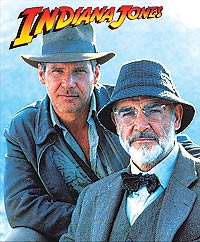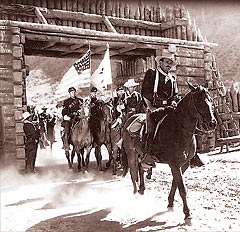|
|
MUSEUM HAPPENINGS - June 2024
Moab’s Legacy of Care Unveiled at Moab Regional Hospital
by Moab Museum Staff
|
 |
Dedication of the I.W. Allen Memorial Hospital in 1957, delivered by Utah Governor George D. Clyde.
Read the full dedication speech in the digital exhibition |
This May, the Moab Museum’s curatorial team unveiled a new temporary exhibition at Moab Regional Hospital titled Moab’s Legacy of Care: A Brief History of Medical Services. The exhibit builds upon the Moab Museum’s range of storytelling beyond the Museum walls and will be on display indefinitely. Moab’s Legacy of Care is available to be viewed in the hallway connecting Moab Regional Hospital with the Canyonlands Care Center.
Moab’s Legacy of Care
Moab’s medical history is defined by dedicated caregivers both inside and outside hospital walls. From doctors making house calls on horseback to nurses hosting supply drives during pandemics, the Moab community has been adapting to rural healthcare challenges for over a century.
In times of financial hardship, the question has been posed, “What is a hospital worth?” But this question inspires yet another conversation, “What is a community’s health worth?”
 |
| Hannah Pittman was one of the hardworking nurses at the Grand County hospital beginning in 1939. Many thanks to the Pittman family for their assistance in sharing and curating these stories. |
Whether excellence is achieved with a larger staff, state-of-the-art equipment, or specialized facilities, it’s the people of Moab and its medical professionals who perpetuate a legacy of healthcare excellence in Moab.
Moab’s Legacy of Care explores four distinct time periods of caregiving in the Moab Valley: before a hospital, Grand County Hospital, I. W. Allen Memorial Hospital, and at present, Moab Regional Hospital. Early healthcare in the Canyonlands region did not come easy, but with the dedication of many individuals, from nurses, non-Western practitioners, pharmacists, dentists, ophthalmologists, hospice care workers, Native healers, and other experts, Moabites have been offered a diverse range of options for community healthcare, options which have only grown since the first doctors and nurses of the Moab Valley.
A Digital Experience
Visitors are invited to explore the storylines in greater depth by visiting the digital exhibition at
moabmuseum.org/exhibition/legacy-of-care. There, profiles of prominent figures throughout Moab’s timeline of caregiving are available from J. W. “Doc” Allen, who accepted the position of “Health Officer” of Grand County for $150 a year and became the town’s sole practitioner until 1920, to “Grandma Brack” and “Aunt Sarah.” Both women were trained midwives and delivered hundreds of babies in locations far from any established medical practice. Stewart settled in Moab in 1880 and acted as Moab’s first doctor and nurse from her home on the corner of Center and Main Street, where Wells Fargo is today. Visitors can view additional documents within the digital exhibition such as Sarah Stewart’s recipe book, photos of Moab’s hospital over the years, and dedication speeches delivered at hospital openings.
Join us in welcoming a new exhibition to the community this spring at Moab Regional Hospital.
The Moab Museum is dedicated to sharing stories of the natural and human history of the Moab area. To explore more of Moab’s stories and artifacts, find out about upcoming programs, and become a member, visit www.moabmuseum.org.
Moab Museum Selected to Participate
in
Collections Assessment for
Preservation Program
by Moab Museum Staff
|
|
Moab Museum announces that it is one of 71 institutions in the United States selected to participate in the Collections Assessment for Preservation (CAP) program.
CAP helps museums improve the care of their collections by providing support for a general conservation assessment of the museum’s collections and buildings. The museum will work with a team of preservation professionals to identify preventive conservation priorities. The final assessment report will help the museum prioritize its collections care efforts in the coming years.
“Archivally housing and preserving the artifacts and archives entrusted to our care is an essential element of the Museum’s mission. This grant award accelerates our progress toward collections care at the highest standards of professional practice.” Forrest Rodgers, Executive Director
The CAP program is administered by the Foundation for Advancement in Conservation through a cooperative agreement with the Institute of Museum and Library Services.
About Moab Museum
The Moab Museum is a cultural and natural history museum dedicated to sharing the rich stories of Moab, Utah, and greater Canyonlands region. It is located at 118 E. Center St. in Moab, Utah and is open from Tuesday-Saturday from 9-5. Learn more at moabmuseum.org.
About FAIC
The Foundation for Advancement in Conservation saves cultural heritage for future generations, protecting it from decay and destruction. Learn more about FAIC at www.culturalheritage.org/foundation.
About IMLS
The Institute of Museum and Library Services is the primary source of federal support for the nation’s libraries and museums. We advance, support, and empower America’s museums, libraries, and related organizations through grantmaking, research, and policy development. Our vision is a nation where museums and libraries work together to transform the lives of individuals and communities. To learn more, visit www.imls.gov and follow us on Facebook, Twitter, and Instagram.
|
|
| Movie & Western Memorabilia Museum at Red Cliffs Lodge |
|  Red Cliffs Lodge, on the banks of the mighty Colorado River, is home to the Moab Museum of Film & Western Heritage. The lodge is built on the old George White Ranch, a key location for nine of the big westerns including Rio Grande, Cheyenne Autumn, Ten Who Dared, The Commancheros, and Rio Conchos. Red Cliffs Lodge, on the banks of the mighty Colorado River, is home to the Moab Museum of Film & Western Heritage. The lodge is built on the old George White Ranch, a key location for nine of the big westerns including Rio Grande, Cheyenne Autumn, Ten Who Dared, The Commancheros, and Rio Conchos.
The late George White was founder of the Moab to Monument Valley Film Commission, the longest ongoing film commission in the world.
In the museum one can learn more about film locations, how the sets are built, and how the filming process is managed on nature’s own sound stage. On display in the museum are production photographs, movie posters, autographed scripts, props from the many pictures filmed in the area, and displays about the western ranching heritage. For information, call Red Cliffs Lodge at 435-259-2002.
 Through the magnificent landscapes of southeastern Utah, writers have been inspired and stories born here. Zane Grey, the famous western novelist, traveled through the area in 1912. His visit inspired him to write his book Riders of the Purple Sage. The book was made into a movie starring Ed Harris and Amy Madigan, and filmed on locations around Moab. Through the magnificent landscapes of southeastern Utah, writers have been inspired and stories born here. Zane Grey, the famous western novelist, traveled through the area in 1912. His visit inspired him to write his book Riders of the Purple Sage. The book was made into a movie starring Ed Harris and Amy Madigan, and filmed on locations around Moab.
A partial list of stars that have made movies in Moab
John Wayne, Maureen O'Hara, Henry Fonda, Lee Marvin,
Rock Hudson, Jimmy Stewart, Richard Boone, Anthony Quinn,
Mickey Rooney, Shirley Temple, Kris Kristofferson, Billy Crystal,
Robert Duvall, Gene Hackman, Bill Murray, Jack Palance, Susan Sarandon, Geena Davis, Ted Danson, Tom Cruise, and many more. |
|
|
|
|
|
|
|
© 2002-2024 Moab Happenings. All rights
reserved.
Reproduction of information contained in this site is
expressly prohibited.
|
|


 Red Cliffs Lodge, on the banks of the mighty Colorado River, is home to the Moab Museum of Film & Western Heritage. The lodge is built on the old George White Ranch, a key location for nine of the big westerns including Rio Grande, Cheyenne Autumn, Ten Who Dared, The Commancheros, and Rio Conchos.
Red Cliffs Lodge, on the banks of the mighty Colorado River, is home to the Moab Museum of Film & Western Heritage. The lodge is built on the old George White Ranch, a key location for nine of the big westerns including Rio Grande, Cheyenne Autumn, Ten Who Dared, The Commancheros, and Rio Conchos. Through the magnificent landscapes of southeastern Utah, writers have been inspired and stories born here. Zane Grey, the famous western novelist, traveled through the area in 1912. His visit inspired him to write his book Riders of the Purple Sage. The book was made into a movie starring Ed Harris and Amy Madigan, and filmed on locations around Moab.
Through the magnificent landscapes of southeastern Utah, writers have been inspired and stories born here. Zane Grey, the famous western novelist, traveled through the area in 1912. His visit inspired him to write his book Riders of the Purple Sage. The book was made into a movie starring Ed Harris and Amy Madigan, and filmed on locations around Moab.